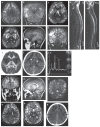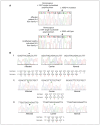Clinical, neuroimaging, and genetic features of L-2-hydroxyglutaric aciduria in Arab kindreds
- PMID: 24894778
- PMCID: PMC6074860
- DOI: 10.5144/0256-4947.2014.107
Clinical, neuroimaging, and genetic features of L-2-hydroxyglutaric aciduria in Arab kindreds
Abstract
Background and objectives: L-2-hydroxyglutaric aciduria is a neurometabolic disorder with autosomal recessive mode of inheritance in which patients exhibit elevated L-2-hydroxyglutaric acid in body fluids, central nervous system manifestations, and increased risk of brain tumor formation. Mutations in L2HGDH gene have been described in L-2-hydroxyglutaric aciduria patients of different ethnicities. The present study was conducted to perform a detailed clinical, imaging and genetic analysis.
Design and settings: A cross-sectional clinical genetic study of 16 L-2-hydroxyglutaric aciduria patients from 4 Arab consanguineous families examined at the metabolic clinic of the hospital.
Patients and methods: Genomic DNA was isolated from the blood of 12 patients and 10 unaffected family members, and the L2HGDH gene was sequenced. DNA sequences were compared to the L2HGDH reference sequence from GenBank.
Results: All patients exhibit characteristic clinical, biochemical, and imaging features of L-2-hydroxyglutaric aciduria, and 4 patients exhibited increased incidence of brain tumors. The sequencing of the L2HGDH gene revealed the c.1015delA, c.1319C > A, and c.169G > A mutations in these patients. These mutations encode for the p.Arg339AspfsX351, p.Ser440Tyr, and p.Gly57Arg changes in the L2HGDH protein, respectively. The c.169G > A mutation, which was shown to have a common origin in Italian and Portuguese patients, was also discovered in Arab patients. Finding of the homozygous c.159T SNP associated with the c.169G > A mutation in Arab patients points to an independent origin of this mutation in Arab population.
Conclusion: The detailed description of clinical manifestations and L2HGDH mutation in this study is useful for diagnosis of L-2-hydroxyglutaric aciduria in Arab patients. While reoccurrence of an L2HGDH mutation in L-2-hydroxyglutaric aciduria patients of different ethnicity is extremely rare, the c.169G mutation has an independent origin in Arab patients. It is likely that this mutation may also be present in patients of other ethnicities.
Figures



Similar articles
-
Two novel L2HGDH mutations identified in a rare Chinese family with L-2-hydroxyglutaric aciduria.BMC Med Genet. 2018 Sep 14;19(1):167. doi: 10.1186/s12881-018-0675-9. BMC Med Genet. 2018. PMID: 30217188 Free PMC article.
-
Novel L2HGDH mutations in 21 patients with L-2-hydroxyglutaric aciduria of Portuguese origin.Hum Mutat. 2005 Oct;26(4):395-6. doi: 10.1002/humu.9373. Hum Mutat. 2005. PMID: 16134148
-
A novel compound heterozygous mutation of the L2HGDH gene in a Chinese boy with L-2-hydroxyglutaric aciduria: case report and literature review.Neurol Sci. 2018 Oct;39(10):1697-1703. doi: 10.1007/s10072-018-3483-2. Epub 2018 Jul 6. Neurol Sci. 2018. PMID: 29980873 Review.
-
[L-2-hydroxyglutaric aciduria caused by a new mutation in the L2HGDH gene].Zh Nevrol Psikhiatr Im S S Korsakova. 2017;117(4):81-85. doi: 10.17116/jnevro20171174181-85. Zh Nevrol Psikhiatr Im S S Korsakova. 2017. PMID: 28617386 Russian.
-
An overview of L-2-hydroxyglutarate dehydrogenase gene (L2HGDH) variants: a genotype-phenotype study.Hum Mutat. 2010 Apr;31(4):380-90. doi: 10.1002/humu.21197. Hum Mutat. 2010. PMID: 20052767 Review.
Cited by
-
L-2-Hydroxyglutaric Acid Administration to Neonatal Rats Elicits Marked Neurochemical Alterations and Long-Term Neurobehavioral Disabilities Mediated by Oxidative Stress.Neurotox Res. 2023 Apr;41(2):119-140. doi: 10.1007/s12640-022-00625-0. Epub 2022 Dec 29. Neurotox Res. 2023. PMID: 36580261
-
The broad spectrum of clinical manifestations observed in three patients with L2 hydroxyglutaric aciduria spans from febrile seizures to complex dystonia.Mol Genet Metab Rep. 2024 Aug 24;41:101135. doi: 10.1016/j.ymgmr.2024.101135. eCollection 2024 Dec. Mol Genet Metab Rep. 2024. PMID: 39262645 Free PMC article.
-
Deep Brain Stimulation of the Globus Pallidus Internus in a Child with Refractory Dystonia due to L2-Hydroxyglutaric Aciduria.Stereotact Funct Neurosurg. 2024;102(4):209-216. doi: 10.1159/000538418. Epub 2024 May 7. Stereotact Funct Neurosurg. 2024. PMID: 38714179 Free PMC article.
-
Identification of novel L2HGDH mutation in a large consanguineous Pakistani family- a case report.BMC Med Genet. 2018 Feb 20;19(1):25. doi: 10.1186/s12881-018-0532-x. BMC Med Genet. 2018. PMID: 29458334 Free PMC article.
-
Rational Computational Approaches in Drug Discovery: Potential Inhibitors for Allosteric Regulation of Mutant Isocitrate Dehydrogenase-1 Enzyme in Cancers.Molecules. 2023 Mar 2;28(5):2315. doi: 10.3390/molecules28052315. Molecules. 2023. PMID: 36903561 Free PMC article.
References
-
- Duran M, Kamerling JP, Bakker HD, van Gennip AH, Wadman SK. L-2-Hydroxyglutaric aciduria: an inborn error of metabolism? J Inherit Metab Dis. 1980;3(4):109–112. - PubMed
-
- Steenweg ME, Jakobs C, Errami A, van Dooren SJ, Adeva Bartolomé MT, et al. An overview of L-2-hydroxyglutarate dehydrogenase gene (L2H-GDH) variants: a genotype-phenotype study. Hum Mutat. 2010;31(4):380–390. Review. - PubMed
-
- Steenweg ME, Salomons GS, Yapici Z, Uziel G, Scalais E, Zafeiriou DI, et al. L-2-Hydroxyglutaric aciduria: pattern of MR imaging abnormalities in 56 patients. Radiology. 2009;251(3):856–865. - PubMed
-
- Haliloglu G, Jobard F, Oguz KK, Anlar B, Akalan N, Coskun T, et al. L-2-hydroxyglutaric aciduria and brain tumors in children with mutations in the L2HGDH gene: neuroimaging findings. Neuropediatrics. 2008;39(2):119–122. - PubMed
-
- Moroni I, Bugiani M, D’Incerti L, Maccagnano C, Rimoldi M, et al. L-2-hydroxyglutaric aciduria and brain malignant tumors: a predisposing condition? Neurology. 2004;62(10):1882–1884. Review. - PubMed
Publication types
MeSH terms
Substances
Supplementary concepts
LinkOut - more resources
Full Text Sources
Other Literature Sources
Medical

